Ask anyone on the Motorcyclist staff to name the best middleweight sportbike on the market, and one of these two bikes will be at the top of the list. The other will be right there in its draft. Both the Kawasaki ZX-6R and the Triumph Daytona 675R are truly outstanding motorcycles. They boast broadband power, they’re laden with impressive components and features, and they offer the kind of telepathic handling that will elevate any rider’s game.
Both the ZX-6R and Daytona 675R break the standard inline-four, 599cc mold with unorthodox engine designs. One has a class-defying 636cc “cheater” motor; the other a new, shorter-stroke triple. Both offer more torque and smoother power delivery than their supersport contemporaries, making them better suited to the street and easier to ride at the track. These two supersports are bound together by their nonconformity, but only one can be the best. It was our pleasure to determine a winner via two days of street riding and a full day strafing apexes at Chuckwalla Valley Raceway in Desert Center, CA.
We’ve delved into the details and heaped praise on both of these bikes before in First Ride reports and road tests, so we’ll just hit the high points and get right into the nitty gritty. Kawasaki’s ZX-6R returned to an old formula for 2013: more displacement. The bike’s motor gets a little more cylinder volume via a stroke increase of 2.6mm, with the airbox, cams, fuel injectors, exhaust, and other supporting systems reworked to suit. Fresh styling, revised suspension, and the addition of Kawasaki’s excellent three-level traction control and switchable engine maps make this the most powerful and technologically advanced Japanese supersport on the market today.
Hinckley’s latest Daytona 675 and up-spec 675R are new from the tires up—and brilliant. A redesigned engine with a 2.7mm shorter stroke and an elevated compression ratio makes more power and revs higher than ever, while a new frame yields sharper and shorter figures for better handling. A mission to reduce and centralize mass sees the exhaust relocated under the engine, while the wheels, rear brake, fairing stay, headlight, and other parts at the bike’s extremities are lighter. New bodywork, updated suspension, new brakes, and switchable ABS with a Circuit mode round out the updates for 2013. For our test we opted for the R-bike, which comes with Öhlins suspension front and rear, an electronic quickshifter, and a splash of carbon fiber.
The 675R we last tested in 2012 was a solid performer, but it didn’t quite stack up to the 636 in the quarter mile, during top-gear roll-ons, or on the dyno. Now, though, the tables have turned. The 2013 Daytona displays better numbers in all the above categories: it puts down 112.9 horsepower to the Ninja’s 112.0 bhp; flies down the dragstrip in 10.54 seconds at 132.05 mph, well ahead of the Ninja’s 10.71 sec. run at 130.96 mph; and the 675 runs away from the Ninja in the top-gear roll-on test, posting a 2.79 sec. time from 60–80 mph, compared to the Kawasaki’s 3.33 sec. At 420 pounds with a full tank, the 675R maintains the weight of the previous bike, 2 lbs. less than the 636. That’s impressive considering the Triumph now carries ABS.
Both bikes are so balanced, with such immediate and stable handling, potent motors, and precise controls, that you feel familiar with them after just a few corners. The Kawasaki’s lower stance, softer seat, and more compliant suspension make it more amicable on the street, and its ultra-light steering (there is no steering damper) makes the bike feel nimble and well-balanced at low speeds. The Triumph stands taller, with stiffer suspension and a firm, narrow seat pad. Both bikes have fairly committed riding positions, but neither machine lacks legroom, and the reach to the clip-ons is reasonable though the Triumph’s bars are noticeably lower and put more pressure on your wrists. As you might expect, the Kawasaki offers a more comfortable ride on the open road, while its wider, taller fairing cuts a bigger hole in the air for its pilot. The Triumph’s short windscreen leaves you wanting more wind protection at highway speeds, making several hours in the saddle feel like it’s longer.
Plentiful low-end torque and near-effortless clutch action mean both bikes jump off the line without fuss, while immediate yet fluid throttle response makes it easy to dial in the perfect amount of power. The Ninja’s transmission is wonderfully smooth, but can’t compare to the ease with which you snick up through the gears on the Triumph—its quickshifter is a pleasure to use.
Chuckwalla is quickly becoming our go-to testing facility. It’s a flowing, corner-centric, 17-turn circuit that rewards handling over horsepower, and as such it was the perfect place to expose the strengths and weaknesses of these two supersports. To ensure both bikes were on equal footing, we levered on Bridgestone’s latest DOT-approved race tire, the R10. Shorter final gearing and more midrange power helped the Triumph fire off apexes with more oomph, but the Ninja’s higher redline meant we could hold a gear between turns in several places, which translated to fewer shifts per lap. And with traction control erasing the fear of highsides, WOT off apex became the norm on the Ninja.
The Triumph’s taller, tauter chassis translates to a knife-edge feel on the racetrack. The front end provides pinpoint accuracy and immediate steering response, making it easy for testers to hit their turn-in points and nail (or adjust) their lines. Like its big brother the ZX-10R, the ZX-6R’s handling is inhibited by a sagging rear end. Steering felt a little sluggish on the street and at the track the bike was slow to turn-in and had a hard time holding a line at exit. Kawasaki mechanic Joey Lombardo remedied the problem with a ride height change of down 2mm in the front and up 8mm in the back, plus several turns of rear spring preload. The treatment worked to quicken steering and improve line-holding to a level that was closer to that of the Triumph, but the Ninja still felt slightly vague at turn-in and took more muscle to steer.
Full lean to full lean, the Kawasaki requires a little more effort, but it gets into corners better thanks to its superior brakes. The Brembos on last year’s Daytona 675R were tremendous, but this year’s setup seems to suffer on account of the new ABS. Brake lever pull is soft through the initial part of the stroke, muddying feel. The Kawasaki brakes don’t have much bite, but they offer tons of feel and stopping power that’s easy to modulate. And the Ninja’s wider, contoured tank lets you carry more weight with your thighs instead of your wrists, so you can brace yourself better and brake later and harder.
The Triumph’s Circuit ABS mode—accessed via the dash while the key is on but the bike is stopped—is more lenient than the standard street setting and didn’t create any additional problems with brake function compared to turning the system off, so we left it on for added safety. Too bad the ABS resets itself to the more conservative standard mode every time you turn the key to off. The Kawasaki’s electronics are easier to use. Having a giant switch for the power modes and TC seems like overkill at first, but once you fumble around with the dash buttons on the 675R trying to turn the ABS off you appreciate the simplicity of the 636’s arrangement.
The Kawasaki’s chassis worked much better after ride-height changes, but it still isn’t as good as the Triumph is right out of the box. The Daytona’s fluffy brakes are a drag on the track, but ABS could be a lifesaver on the street. ABS is available as a $1000 option on the ZX-6R, pushing the price to $12,699, while the 675R is further up the scale at $13,499. If that’s too much to swallow, the base model Daytona is $11,599 and still comes with the same great engine and ABS.
On paper and on the track, these bikes are remarkably similar—our fastest tester’s best laps on each bike were separated by just 0.03 sec. But the 636 and the 675 are very different in terms of character. The Kawasaki is a tremendously good motorcycle but it lacks the Triumph’s charisma—something we said about the 636 against the previous Daytona. And performance without a bit of attitude just doesn’t do it for us. So the Daytona wins on both fronts: superior performance and a personality that accentuates its capabilities. We call that the king of the class. Again.
Stephen Gould
Guest Tester
Age: 27
Height: 5'10"
Weight: 150 lbs.
Inseam: 32 in.
For me, local club racer on a tight budget, a brand new ride is a bit of a stretch. However, if put in this position, I would absolutely fork over the extra $1800 for Triumph’s new 675R. The revived 636 from Kawasaki is an excellent all-around motorcycle with great midrange power and smooth handling, but doesn’t have all the extras included in the Triumph package. The Ohlins front end, TTX rear shock, quickshifter, and charismatic powerplant all produce a competitive bike right out of the box. The razor-sharp handling, punchy powerband, and solid frame all surpass those of the Kawasaki for a relatively marginal cost. It really is amazing what you get in the 675R for less than $14,000.
Zack Courts
Associate Editor
Age: 29
Height: 6'2"
Weight: 185 lbs.
Inseam: 34 in.
The 636 is a tremendous sportbike. It’s smooth, powerful, feature-laden, and comfortable on the street. It’s also quite a bit cheaper than Triumph’s 675R, even with power modes and traction control. But I’d still take the Trumpet. Other than the front brakes losing feel with the addition of ABS, the 675R does everything a sportbike should while stirring my soul with every rev. I love the throaty growl of the triple, and the way the 675 makes power is definitely more usable on the street. If you want a great sportbike and you like green, get the 636. I guess I’m just a sucker for Euro charm.
Both bikes leave your average 600 for dead with flatter lines and more space under the curve. The Daytona cranks out 35 lb.-ft. of torque at just 3500 rpm, while the Ninja doesn’t cross that line for another 2500 rpm. It’s a game of catch-up all the way to 14,000 rpm, where the Triumph hits an electronically mandated wall while the Kawasaki keeps on spinning.
The 675R is slimmer between your knees and firmer under your backside, while the Ninja is wider, lower, and softer. Better wind protection and softer suspension go a long way toward making long days in the Ninja saddle bearable. Legroom is ample on both bikes. The Daytona’s clip-ons are racebike-low, but they’re almost an inch closer to the rider than the Ninja’s bars.
Tech Spec
Engine type: l-c inline-four
Valve train: DOHC, 16v
Displacement: 636cc
Bore x stroke: 67.0 x 45.1mm
Compression: 12.9:1
Fuel system: EFI
Clutch: Wet, multi-plate slipper
Transmission: 6-speed
Measured horsepower: 112.0 bhp @ 13,300 rpm
Measured torque: 46.4 lb.-ft. @ 11,300 rpm
Corrected 1⁄4-mile: 10.71 sec. @ 130.96 mph
Top-gear roll-on 60–80 mph: 3.33 sec.
Fuel mileage (hi/low/avg.): 43/34/40 mpg
Frame: Aluminum twin-spar
Front suspension: Showa 41mm BP-SFF with adjustable spring preload, compression and rebound damping
Rear suspension: Showa shock with adjustable spring preload, compression and rebound damping
Front brake: Dual Nissin four-piston calipers, 310mm discs
Rear brake: Nissin single-piston caliper, 220mm disc
Front tire: 120/70ZR-17 Bridgestone S20
Rear tire: 180/55ZR-17 Bridgestone S20
Rake/trail: 23.5°/4.0 in.
Seat height: 32.7 in.
Wheelbase: 54.9 in.
Fuel capacity: 4.5 gal.
Weight (tank full/empty): 422/395 lbs.
Colors: Green, white, black
Available: Now
Warranty: 12 mo., unlimited mi.
Contact: www.kawasaki.com
Engine type: l-c inline-triple
Valve train: DOHC, 12v
Displacement: 675cc
Bore x stroke: 76.0 x 49.6mm
Compression: 13.0:1
Fuel system: EFI
Clutch: Wet, multi-plate slipper
Transmission: 6-speed
Measured horsepower: 112.9 bhp @ 12,800 rpm
Measured torque: 48.6 lb.-ft. @ 10,000 rpm
Corrected 1⁄4-mile: 10.54 sec. @ 132.05 mph
Top-gear roll-on 60-80 mph: 2.79 sec.
Fuel mileage (hi/low/avg.): 43/35/40 mpg
Frame: Aluminum twin-spar
Front suspension: Öhlins 43mm NIX30 fork with adjustable spring preload, compression and rebound damping
Rear suspension: Öhlins TTX36 shock with adjustable spring preload, compression and rebound damping
Front brake: Dual Brembo four-piston calipers, 310mm discs with ABS
Rear brake: Brembo single-piston caliper, 220mm disc with ABS
Front tire: 120/70ZR-17 Pirelli Diablo Supercorsa SP
Rear tire: 180/55ZR-17 Pirelli Diablo Supercorsa SP
Rake/trail: 22.9°/3.4 in.
Seat height: 32.7 in.
Wheelbase: 54.1 in.
Fuel capacity: 4.6 gal.
Weight (tank full/empty): 420/392 lbs.
Colors: Crystal White
Available: Now
Warranty: 24 mo., unlimited mi.
Contact: www.triumphmotorcycles.com











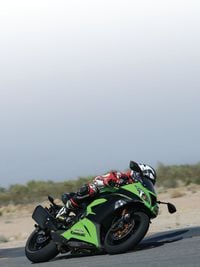




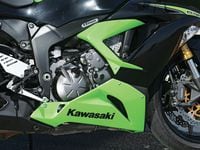

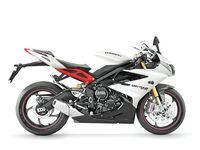
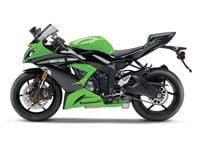



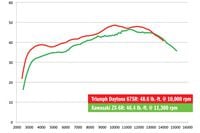
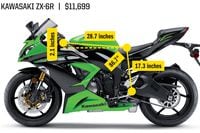

/cloudfront-us-east-1.images.arcpublishing.com/octane/7GJYDUIPXRGMTMQKN6ONYOLBOU.jpg)
/cloudfront-us-east-1.images.arcpublishing.com/octane/MUQLOVLL2ZDGFH25ILABNBXKTI.jpg)
/cloudfront-us-east-1.images.arcpublishing.com/octane/TNOU5DNE2BC57MFPMGN2EIDXAM.jpg)
/cloudfront-us-east-1.images.arcpublishing.com/octane/GTCXACQGJ5HAPDTGWUQKDEH44E.jpg)
/cloudfront-us-east-1.images.arcpublishing.com/octane/S35YGSEMEZB4BLTDJTSZPF4GLA.jpg)
/cloudfront-us-east-1.images.arcpublishing.com/octane/5UOT6HPX2JFMRJAX6EH45AR4MQ.jpg)
/cloudfront-us-east-1.images.arcpublishing.com/octane/OKWOJWAKP5EP3OACCRRWPCIX2Q.jpg)
/cloudfront-us-east-1.images.arcpublishing.com/octane/2WF3SCE3NFBQXLDNJM7KMXA45E.jpg)
/cloudfront-us-east-1.images.arcpublishing.com/octane/G4MG6OUCJNBSHIS2MVVOTPX65E.jpg)
/cloudfront-us-east-1.images.arcpublishing.com/octane/IIGGWFOTOJGB7DB6DGBXCCMTDY.jpg)
/cloudfront-us-east-1.images.arcpublishing.com/octane/QSTCM6AVEZA5JJBUXNIQ3DSOF4.jpg)
/cloudfront-us-east-1.images.arcpublishing.com/octane/U4I7G625B5DMLF2DVIJDFZVV6M.jpg)
/cloudfront-us-east-1.images.arcpublishing.com/octane/B6XD6LS6IVCQPIU6HXDJSM3FHY.jpg)
/cloudfront-us-east-1.images.arcpublishing.com/octane/ICL63FEDDRDTTMINYICCEYGMDA.jpg)
/cloudfront-us-east-1.images.arcpublishing.com/octane/FCGZHQXRBZFLBAPC5SDIQLVF4I.jpg)
/cloudfront-us-east-1.images.arcpublishing.com/octane/WNOB6LDOIFFHJKPSVIWDYUGOPM.jpg)

/cloudfront-us-east-1.images.arcpublishing.com/octane/X33NU3E525ECRHXLNUJN2FTRKI.jpg)
/cloudfront-us-east-1.images.arcpublishing.com/octane/6KKT5NNL2JAVBOXMZYS5ZO76YA.jpg)
/cloudfront-us-east-1.images.arcpublishing.com/octane/J5RKG5O455GMPGQRF2OG6LRT7A.jpg)
/cloudfront-us-east-1.images.arcpublishing.com/octane/GX2CIZKQVRH2TATDM26KFG2DAE.jpg)
/cloudfront-us-east-1.images.arcpublishing.com/octane/ZWIDYSAKQZHD5BHREMQILXJCGM.jpg)
/cloudfront-us-east-1.images.arcpublishing.com/octane/CYUHJZCTSJCH3MRAQEIKXK7SCQ.jpg)
/cloudfront-us-east-1.images.arcpublishing.com/octane/LKOFINY56FCXJCANJ5M7ZDQUBY.jpg)